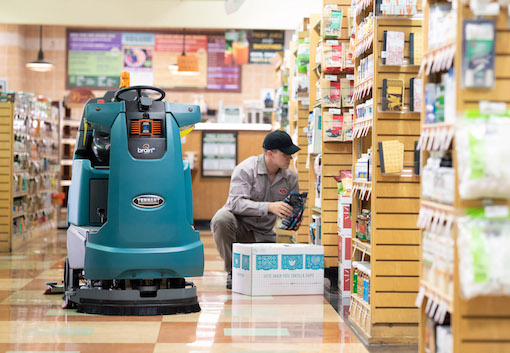 Cleanzine: your weekly cleaning and hygiene industry newsletter 10th July 2025 Issue no. 1170
Cleanzine: your weekly cleaning and hygiene industry newsletter 10th July 2025 Issue no. 1170
Your industry news - first
The original and best - for over 20 years!
We strongly recommend viewing Cleanzine full size in your web browser. Click our masthead above to visit our website version.
How robots are helping facilities stay clean post-pandemic
 by Michel Spruijt, GM and VP of BrainCorp Europe…
by Michel Spruijt, GM and VP of BrainCorp Europe…
“Owing to a devastating pandemic, keeping public spaces clean has shifted from being a background routine to a forefront concern. This jolt in priorities has been especially felt by anyone managing industrial facilities.
There's a new need for cleaning operations to be verifiable; managers need clear proof of what's been cleaned and when the cleaning took place.
To meet this demand, growing numbers of commercial cleaning robots have been deployed since the outbreak of Covid-19. Technology has seen a significant uptake over the last year as the pandemic forced many facilities to adapt their ways of operating. While autonomous robots have been on a steady increase in usage in recent years, 2020 brought their value into a clearer focus.
This benchmark looks to be set. According to a recent study carried out by RetailWire and Brain Corp, 73% of supply chain managers have stated that robotics will be essential for businesses in the future. The study also shows that nearly half of all retailers plan to have an in-store robotics automation project underway in the next 18 months. These findings are the unequivocal result of a successful trial of greater automation in facilities.
Robots as co-workers…
Before the pandemic, Autonomous Mobile Robots were making inroads across facilities as the need for greater efficiency in operations became an increasing priority. But these machines were often seen as more novelty than necessity. However, thanks to AI-powered navigation systems and the ability to be swiftly and easily deployed, mobile robots have progressed beyond tightly controlled industrial niches and into more dynamic, public environments. The ability to work alongside humans in unpredictable environments offers new value to managers, presenting a new standard of trackable, round-the-clock cleaning in the facilities management sector.
However, the benefits brought to facilities by floor scrubbing robots are not limited to 24/7 cleaning. It also means that facilities managers can flexibly reassign team members from low-value, repetitive, and more arduous tasks like manning manual floor scrubbers or hauling heavy delivery carts, to more pressing responsibilities, such as deep cleaning high traffic areas or supporting customers. In turn, deploying robots strategically in this way increases staff productivity. According to Brain Corp data, throughout 2020, its cleaning robots generated 3.3 million operational hours, relieving teams working in various high-traffic public spaces.
What's more, thanks to the reliable automation of floor sanitisation, cleaning operations have experienced a more thorough division of labour, which allows for the multitude of maintenance tasks to be tackled with greater efficiency than before. As responsibilities have become more specialised, staff members cross paths less often, thus reducing the risk of Covid-19 exposure whilst on the job.
Verifiably clean…
With the bar high for the post-Covid world we are now entering, safety is set to stay as a major concern, with cleanliness a top priority for facilities managers and the public. According to a recent report from Accenture, in the fallout from Covid-19, 64% of those surveyed are fearful of their health, while 82% fear for the health of others.
To combat this issue, AMRs are constantly updated with improved software via the cloud to include features that allow them to level up their effectiveness on a continuous basis. Being able to amass rich cleaning data while deployed allows facilities managers to track robots' cleaning performance, which helps inform better process management. These machines provide verifiable snapshots of their cleaning routes, which means that health managers can comply better with safeguarding and hygiene standards in facilities. Traditional manual methods simply cannot produce this rich data experience, which allows operations and facilities managers to prove the work they have directed, and optimise the daily performance of their cleaning operations. With a digitised perspective, facilities managers can meet corporate compliance goals with greater confidence and accuracy. Plus, because AMRs visibly indicate a strong commitment to cleaning and innovation when deployed, customers and staff alike can feel confident their safety is prioritised.
A futuristic solution…
The past year has been a watershed year for robotics due to an unprecedented health crisis in modern times. Within a short time, robots have become benchmark partners in successfully managing cleaning operations in high-density public spaces. This is a timely intervention, given that the most recent Royal Institution of Chartered Surveyors report states that cleaning is tipped to grow considerably over the next 12 months. As the future rolls into view, the continued uptake of autonomous robotic units will inevitably mean cleaner, safer facilities and more efficient operations.”
12th August 2021







